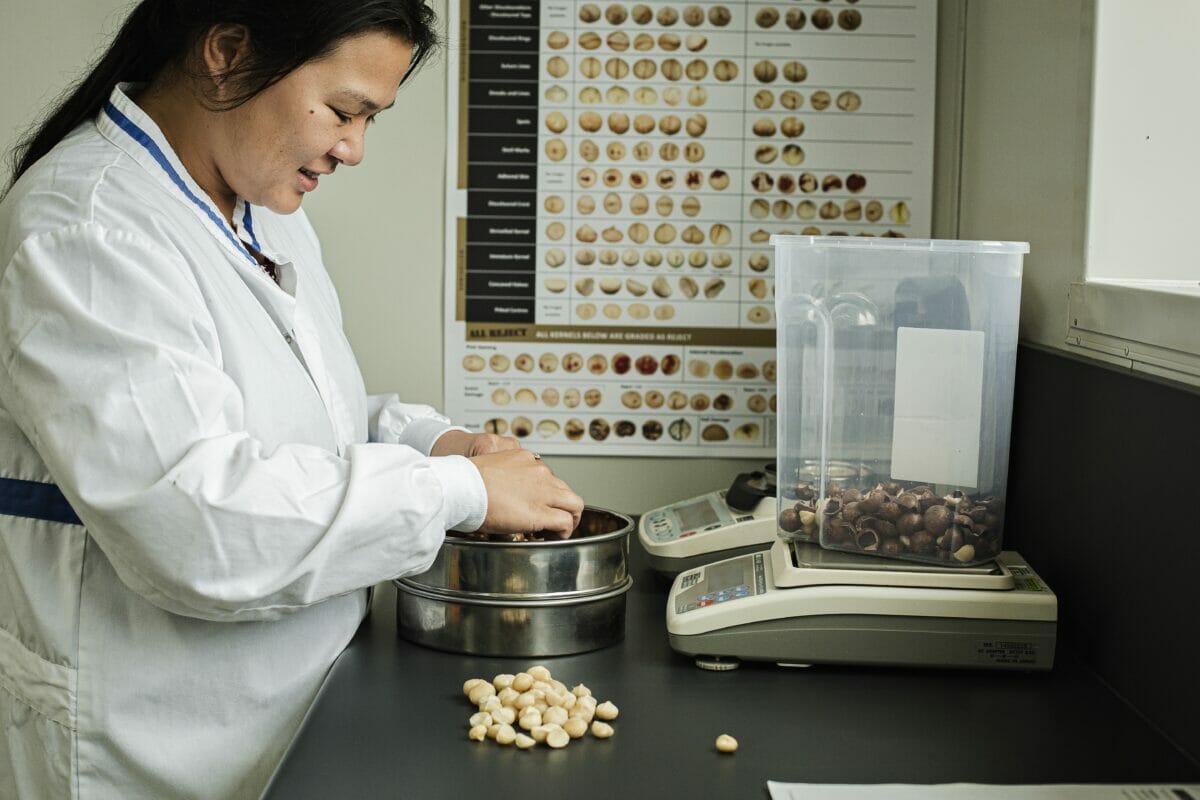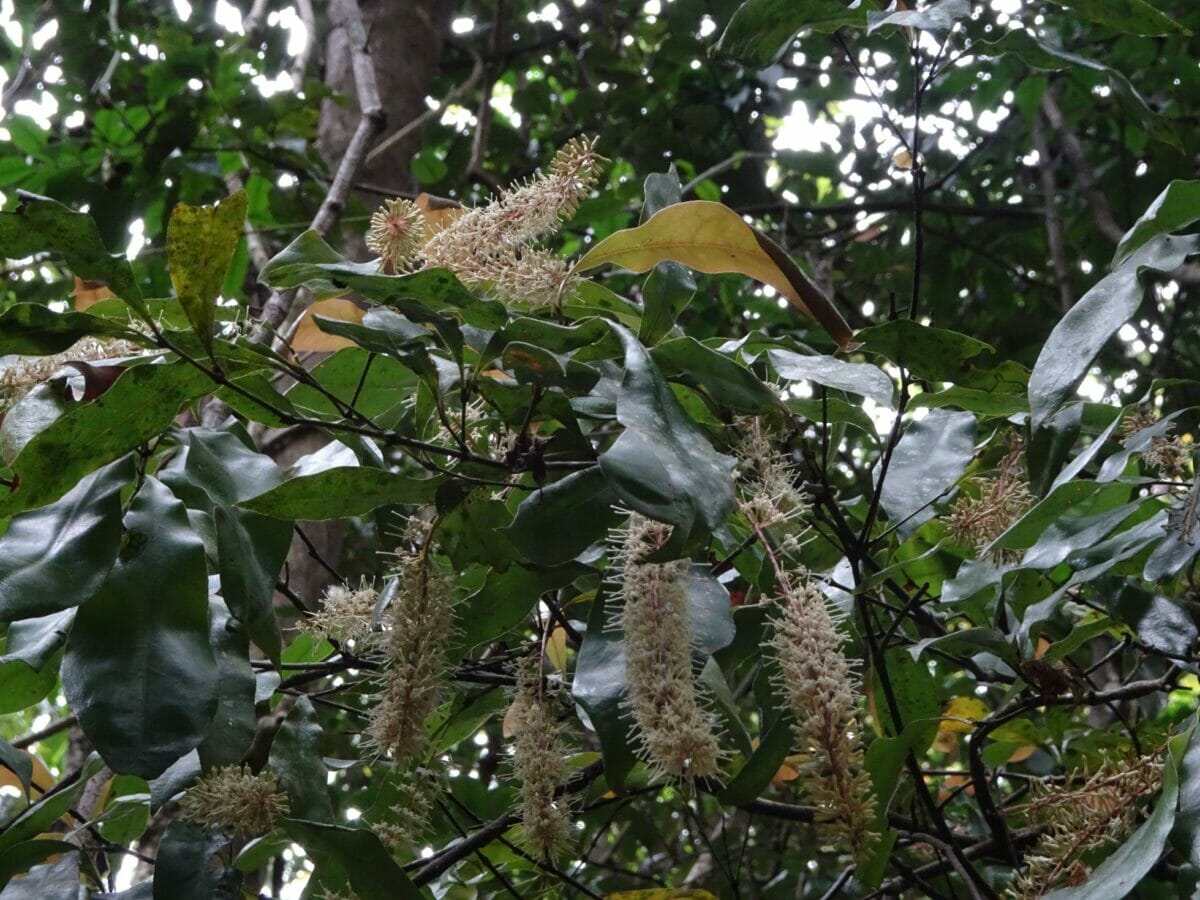The Plan to Save Australia’s Wild Macadamia Trees
In an effort to ensure the future of the world’s most expensive nut, scientists are working to preserve the genetic diversity of macadamia trees in their native land.
The Plan to Save Australia’s Wild Macadamia Trees
In an effort to ensure the future of the world’s most expensive nut, scientists are working to preserve the genetic diversity of macadamia trees in their native land.

The history of the macadamia nut’s domestication means that crops under cultivation largely lack genetic diversity.courtesy of Macadamias Australia.
Ian McConachie has spent much of the past 50 years tramping through the rainforest on the hunt for wild macadamia trees. “Finding a wild macadamia is akin to the thrill of finding gold,” he says.
Yet it’s not the sweet buttery nuts that command up to $25 per pound for which he’s searching but rather the living gene bank that exists within the last remaining wild trees.
Macadamias evolved in the cool, lush rainforests on Australia’s east coast around 50 million years ago and were once ubiquitous there. But McConachie estimates that around 90 percent of wild macadamia trees have been lost since European settlement, while all four species are classified as endangered due to scattered distribution, habitat loss and other impacts.
That hasn’t stopped macadamia nuts from becoming Australia’s largest native export, with around 50,000 tonnes produced each year, according to the Australian Macadamia Society, an industry body representing more than 700 growers.
Globally, the macadamia industry has also undergone rapid expansion in the last 50 years, with Australia, South Africa, Kenya and the United States being the largest producers. Crops are also cultivated in China, South East Asia, South America, Malawi and New Zealand.
But, as with many commercial crops, the history of the nut’s domestication means that crops under cultivation largely lack genetic diversity.

According to research published in Frontiers in Plant Science in 2019, the macadamia variety on which the global industry relies may have originated from a single tree or, at most, a handful of trees, taken from Queensland to Hawaii, where the crop was first grown commercially, in the 19th century.
“So, probably 60 percent of macadamia trees planted in Australia and 80 percent planted in the rest of the world have a very limited genetic base,” McConachie says.
A lack of genetic variability leaves plants vulnerable to emerging pests, disease, natural disasters such as Australia’s “Black Summer” 2019-2020 bushfires and, ultimately, climate change.
For that reason, the Macadamia Conservation Trust, founded by McConachie in 2007, has recently launched a project with Macadamias Australia, a major family-run producer, to create an arboretum of wild-sourced macadamia trees that will serve as an “insurance population.”
“We’re conserving [wild macadamia trees] because they’re part of Australia’s heritage and because of their long-term breeding potential,” McConachie explains.
A nursery housing the first 38 saplings, out of a planned 640, can be found 20 minutes’ drive south from Macadamias Australia’s new $25-million AUD ($17.8-million USD) processing facility and visitor center.
Macadamias Australia’s orchard general manager John Vaughan says that the organization has set aside two precious hectares where trees propagated from wild cuttings will be planted. All four species will be represented, but the collection is starting with the most vulnerable, the Macadamia jansenii, which is as rare as Australia’s Wollemi Pine.
Only 200 individual Macadamia jansenii trees remain in the wild, all in Bulburin National Park to the north, where they had a close call when bushfires ripped through the area in 2018. “[The fires] got within 10 kilometers of that population,” says Vaughan.
The project has gotten off to a slow start, due to years of drought and other issues complicating the collection process. However, when complete, it will be the country’s largest macadamia conservation project.
Meanwhile, scientists are exploring wild macadamia DNA in the quest for favorable traits, such as greater disease resistance and lower oil content.

Robert Henry, professor of innovation in agriculture at the University of Queensland, says researchers are midway through a three-year program probing the DNA of 300 to 400 different macadamia varieties. The aim is to produce a high-quality reference sequence of the genome of the four species. This will help guide collection efforts and prioritize conservation activities. The team has characterized more than 30,000 genes governing everything from taste to tree size.
Although only two species (Macadamia integrifolia and Macadamia tetraphylla) produce edible raw nuts, a better understanding of the genetics governing even the bitter species (Macadamia ternifolia and Macadamia jansenii) can be useful. “They still potentially have characteristics that would be important in the breed,” says Henry.
Desired characteristics include a high kernel recovery (ratio of nut to shell), along with small stature, which is considered “highly desirable” in a horticultural tree crop because it makes harvesting and high-density planting easier.
As such research begins to bear fruit, McConachie hopes the conservation message will catch on more broadly through a publicly accessible “Walk with Wild Macadamias” project currently under construction near Gympie, in the Sunshine Coast hinterland. Once completed, visitors will be able to spot the trees, which can live for more than 100 years.
“They are truly iconic plants that are under real threat from past habitat loss and fragmentation, weed invasion, development and climate change,” he says. “We cannot stand idly by when we have the capacity to do something about it.”
Follow us
This work is licensed under a Creative Commons Attribution-NoDerivatives 4.0 International License.
Want to republish a Modern Farmer story?
We are happy for Modern Farmer stories to be shared, and encourage you to republish our articles for your audience. When doing so, we ask that you follow these guidelines:
Please credit us and our writers
For the author byline, please use “Author Name, Modern Farmer.” At the top of our stories, if on the web, please include this text and link: “This story was originally published by Modern Farmer.”
Please make sure to include a link back to either our home page or the article URL.
At the bottom of the story, please include the following text:
“Modern Farmer is a nonprofit initiative dedicated to raising awareness and catalyzing action at the intersection of food, agriculture, and society. Read more at <link>Modern Farmer</link>.”
Use our widget
We’d like to be able to track our stories, so we ask that if you republish our content, you do so using our widget (located on the left hand side of the article). The HTML code has a built-in tracker that tells us the data and domain where the story was published, as well as view counts.
Check the image requirements
It’s your responsibility to confirm you're licensed to republish images in our articles. Some images, such as those from commercial providers, don't allow their images to be republished without permission or payment. Copyright terms are generally listed in the image caption and attribution. You are welcome to omit our images or substitute with your own. Charts and interactive graphics follow the same rules.
Don’t change too much. Or, ask us first.
Articles must be republished in their entirety. It’s okay to change references to time (“today” to “yesterday”) or location (“Iowa City, IA” to “here”). But please keep everything else the same.
If you feel strongly that a more material edit needs to be made, get in touch with us at [email protected]. We’re happy to discuss it with the original author, but we must have prior approval for changes before publication.
Special cases
Extracts. You may run the first few lines or paragraphs of the article and then say: “Read the full article at Modern Farmer” with a link back to the original article.
Quotes. You may quote authors provided you include a link back to the article URL.
Translations. These require writer approval. To inquire about translation of a Modern Farmer article, contact us at [email protected]
Signed consent / copyright release forms. These are not required, provided you are following these guidelines.
Print. Articles can be republished in print under these same rules, with the exception that you do not need to include the links.
Tag us
When sharing the story on social media, please tag us using the following: - Twitter (@ModFarm) - Facebook (@ModernFarmerMedia) - Instagram (@modfarm)
Use our content respectfully
Modern Farmer is a nonprofit and as such we share our content for free and in good faith in order to reach new audiences. Respectfully,
No selling ads against our stories. It’s okay to put our stories on pages with ads.
Don’t republish our material wholesale, or automatically; you need to select stories to be republished individually.
You have no rights to sell, license, syndicate, or otherwise represent yourself as the authorized owner of our material to any third parties. This means that you cannot actively publish or submit our work for syndication to third party platforms or apps like Apple News or Google News. We understand that publishers cannot fully control when certain third parties automatically summarize or crawl content from publishers’ own sites.
Keep in touch
We want to hear from you if you love Modern Farmer content, have a collaboration idea, or anything else to share. As a nonprofit outlet, we work in service of our community and are always open to comments, feedback, and ideas. Contact us at [email protected].by Denise Cullen, Modern Farmer
February 21, 2022
Modern Farmer Weekly
Solutions Hub
Innovations, ideas and inspiration. Actionable solutions for a resilient food system.
ExploreExplore other topics
Share With Us
We want to hear from Modern Farmer readers who have thoughtful commentary, actionable solutions, or helpful ideas to share.
SubmitNecessary cookies are absolutely essential for the website to function properly. This category only includes cookies that ensures basic functionalities and security features of the website. These cookies do not store any personal information.
Any cookies that may not be particularly necessary for the website to function and are used specifically to collect user personal data via analytics, ads, other embedded contents are termed as non-necessary cookies.